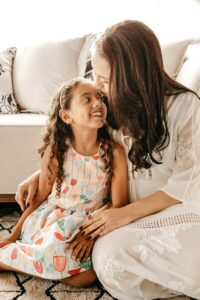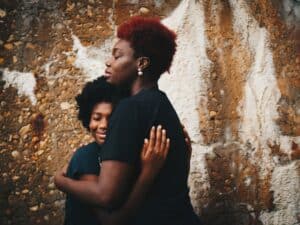“I want you to remember two things.” I kneel before her and gently move the hair out of her face.
“Family is the people who love you and want what’s best for you. Your’s is huge.” I can feel the emotion rising as my throat gets tight and my eyes well with tears, all too familiar over the past few days.
“And, home is where you feel loved. You have many.” I lean in to hug her, partially for her, but mostly so I can look away from her hazel eyes that have a story with more pain than I can take in at this moment.
My foster daughter is 8. And, she is no longer “mine”. I dropped her off with strangers to become her third foster family in two years. She is no stranger to hard things and has hardened her heart because of it. This breaks mine.
We knew this day would come for our foster loves, and still I don’t feel ready. I’m not ready to be the one linked to another unexpected change, to another strange home, to another break in her connection, relationships, and attachment.
And, it’s not about me. It’s all about her.
Over the past two weeks, it’s as if each time the phone rang, a new plan was in the works for the lives of the ones in our care. And it’s left to me to speak with clarity, compassion, honesty, and love as I deliver the most current information.
They are leaving our home.
These moments become chapters in the stories of their lives, where our kids learn about truth, and uncertainty, and compassion and trust.
As I look back on the moments of parenthood that include life-changing conversations, the passing of my father, the loss of our dog, becoming a big brother after 12 years as an only child, and the most difficult, Santa and Larry the elf, I see common themes of things that have gone well, and reactions I never want to see again. (Believe it or not, Santa was the worst!)
Your stories may be different, but the moments of complexity are the same.
There is meaning from the mess, and these tools make difficult conversations more manageable.
1. Build a relationship of trust.

“You can believe the words that I say.” This phrase was repeated daily as I built trust with my foster daughter over the past 13 months. Her story has been uncertain, and I wanted her to know I am someone she could count on.
At 6, she went to school on a day like any other, and by the end of the day had picked up her new baby brother from the hospital and moved into her first foster home.
10 months later, she went to therapy with her foster mother and learned she was moving into our home.
In between, she has had disappointments with canceled visits, empty promises about moving home, and a limited ability to make meaning of it all.
Every day, work to hold true to your word, tell the truth with compassion and awareness of your child’s age, and be someone they can count on.
Trust is not built through grand gestures, but through a series of consistent and predictable responses where your actions reflect your words, over, and over, again.
If I told her she could swim after dinner, I made sure she swam, if only for a short time. When we had a change in routine or her visit was canceled, I told her as soon as I knew to prepare her. I even got her out of bed one evening to take her for ice cream in her pajamas. Because I told her we would go. Our relationship of trust was more important than her bedtime, and it’s something she remembers. Not because we had Brewster’s in pajamas, but because I came through when she thought I was going to let her down.
2. Give them your full attention.

We’re busy mothers, and can review homework, coordinate practice times, and picture day while multitasking, but big conversations require your full attention.
Set time aside when both of you are well-rested, free from distractions, and available to process information and emotions.
Set your phone down, turn off the television, and sit in a space that is neutral and safe.
Our foster daughter had spent the weekend with her new foster family, thinking they were additional mentors in her life. Upon her return, we all sat together to focus on her.
The entire family gathered in the living room. She was surrounded by people who love her, and every one of us was there for her. When she looks back on this moment in her life, another unexpected and monumental change, she will remember that the room was filled with people focused specifically on supporting her.
3. Be clear and direct.

As a parent, it’s a fine line between telling our children the truth and protecting them. You have to know your child.
I know my foster daughter was about to have another disruption in her life, and while this could lead to greater deficits with attachment, this conversation could also lead to a greater understanding of what it looks like to have an adult in her life that speaks truth and lives it.
I turn to her. “We have had conversations about how difficult it can be to get extra attention in a family of six, with two babies. We got a call from the caseworker letting us know that you and your brother will be moved to a family without other children, in order to give you more attention.”
This is true. It is direct. It is clear.
Yes, there is more information I did not share, because it is unclear even to me as an adult. I shared what she needed to know in this moment. This moment is about giving her the information she needs.
I went on to give her the logistics of when she would be moving, and that the family she had spent the previous two weekends with, would be her new foster parents.
4. Be vulnerable and open.

Vulnerability is messy. So is parenting. Children learn to understand and express emotion through the models they see, and the space they are given to explore their own feelings.
This was not about me.
This is tricky because I have all kinds of emotions that range from confusion, frustration, sadness, hope, surrender, and a longing for rest.
None of them are for her to carry.
What she did need to see is that I was sincere in my happiness for her to have more of what she needs, in a home with more attention. And, that I was sad she would no longer live in our home. All of that is about her.
My vulnerability reflected our connection, her value, and my humanity. It allowed her to have multiple feelings all at once, to be excited and sad. To be confused and optimistic. To want to stay, and to want to go.
Honoring multiple feelings surrounding one event is complicated, and it is what happens. Modeling and honoring that as an adult allows children the space to do the same.
5. Allow them to ask questions and give honest age-appropriate answers.

Children naturally have questions, and when making sense of big information, even more questions may arise. Let them know you understand the information may need clarification, and answer questions with them in mind. Tell them what they need to know to understand what is happening, and clarify understanding.
Our foster daughter immediately told us she had no questions. She detached and protected herself with a wall of protection. The words went in, but the feelings were impenetrable.
Be willing to circle back. Lets kids know that if questions arise at a later time, you want to talk it through. The conversation is not over. You are still open and willing to continue when the child is ready.
Memories are linked to emotion, and it’s beautiful when in the midst of difficult conversations, our children can feel support, connection, and a sense of trust even when the information is difficult to process and hear.
We can’t rewrite the chapters that become the stories of their lives, but we can be the supporting role to remind them, we’re in it together.



